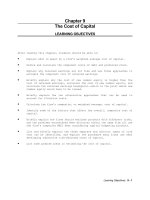Financial managment Solution Manual: Bonds and Their Valuation
Bạn đang xem bản rút gọn của tài liệu. Xem và tải ngay bản đầy đủ của tài liệu tại đây (70.77 KB, 4 trang )
Answers and Solutions: 7 - 1
Chapter 7
Bonds and Their Valuation
7-1 With your financial calculator, enter the following:
N = 10; I = YTM = 9%; PMT = 0.08 × 1,000 = 80; FV = 1000; PV = V
B
= ?
PV = $935.82.
PV = (PMT*PVIFA
9%, 10
) + (FV*PVIF
9%, 10
)
= 80*6.4177 + 1000*.4224
= $935.82
7-2 With your financial calculator, enter the following to find YTM:
N = 10 × 2 = 20; PV = -1100; PMT = 0.08/2 × 1,000 = 40; FV = 1000; I = YTM = ?
YTM = 3.31% × 2 = 6.62%.
With your financial calculator, enter the following to find YTC:
N = 5 × 2 = 10; PV = -1100; PMT = 0.08/2 × 1,000 = 40; FV = 1050; I = YTC = ?
YTC = 3.24% × 2 = 6.49%.
7-3 The problem asks you to find the price of a bond, given the following
facts: N = 16; I = 8.5/2 = 4.25; PMT = 45; FV = 1000.
With a financial calculator, solve for PV = $1,028.60.
7-4 V
B
= $985; M = $1,000; Int = 0.07 × $1,000 = $70.
a. Current yield = Annual interest/Current price of bond
= $70/$985.00
= 7.11%.
b. N = 10; PV = -985; PMT = 70; FV = 1000; YTM = ?
Solve for I = YTM = 7.2157% ≈ 7.22%.
c. N = 7; I = 7.2157; PMT = 70; FV = 1000; PV = ?
Solve for V
B
= PV = $988.46.
7-5 a. 1. 5%: Bond L: Input N = 15, I = 5, PMT = 100, FV = 1000, PV = ?,
PV = $1,518.98.
Bond S: Change N = 1, PV = ? PV = $1,047.62.
Answers and Solutions: 7 - 2
SOLUTIONS TO END-OF-CHAPTER PROBLEMS
2. 8%: Bond L: From Bond S inputs, change N = 15 and I = 8, PV = ?,
PV = $1,171.19.
Bond S: Change N = 1, PV = ? PV = $1,018.52.
3. 12%: Bond L: From Bond S inputs, change N = 15 and I = 12, PV
= ?, PV = $863.78.
Bond S: Change N = 1, PV = ? PV = $982.14.
b. Think about a bond that matures in one month. Its present value is
influenced primarily by the maturity value, which will be received in
only one month. Even if interest rates double, the price of the bond
will still be close to $1,000. A 1-year bond’s value would fluctuate
more than the one-month bond’s value because of the difference in the
timing of receipts. However, its value would still be fairly close
to $1,000 even if interest rates doubled. A long-term bond paying
semiannual coupons, on the other hand, will be dominated by distant
receipts, receipts that are multiplied by 1/(1 + k
d
/2)
t
, and if k
d
increases, these multipliers will decrease significantly. Another
way to view this problem is from an opportunity point of view. A 1-
month bond can be reinvested at the new rate very quickly, and hence
the opportunity to invest at this new rate is not lost; however, the
long-term bond locks in subnormal returns for a long period of time.
7-6 a. V
B
=
∑
=
+
+
+
N
1t
N
d
t
d
)k1(
M
)k1(
INT
M = $1,000. I = 0.09($1,000) = $90.
1. V
B
= $829: Input N = 4, PV = -829, PMT = 90, FV = 1000, I = ? I =
14.99%.
2. V
B
= $1,104: Change PV = -1104, I = ? I = 6.00%.
b. Yes. At a price of $829, the yield to maturity, 15 percent, is
greater than your required rate of return of 12 percent. If your
required rate of return were 12 percent, you should be willing to buy
the bond at any price below $908.88.
7-8 a. Using a financial calculator, input the following:
N = 20, PV = -1100, PMT = 60, FV = 1000, and solve for I = 5.1849%.
However, this is a periodic rate. The nominal annual rate =
5.1849%(2) = 10.3699% ≈ 10.37%.
b. The current yield = $120/$1,100 = 10.91%.
c. YTM = Current Yield + Capital Gains (Loss) Yield
10.37% = 10.91% + Capital Loss Yield
-0.54% = Capital Loss Yield.
Integrated Case: 7 - 3
d. Using a financial calculator, input the following:
N = 8, PV = -1100, PMT = 60, FV = 1060, and solve for I = 5.0748%.
However, this is a periodic rate. The nominal annual rate =
5.0748%(2) = 10.1495% ≈ 10.15%.
7-11 The bond is selling at a large premium, which means that its coupon rate
is much higher than the going rate of interest. Therefore, the bond is
likely to be called it is more likely to be called than to remain
outstanding until it matures. Thus, it will probably provide a return
equal to the YTC rather than the YTM. So, there is no point in
calculating the YTM just calculate the YTC. Enter these values:
N = 10, PV = -1353.54, PMT = 70, FV = 1050, and then solve for I.
The periodic rate is 3.2366 percent, so the nominal YTC is 2 × 3.2366% =
6.4733% ≈ 6.47%. This would be close to the going rate, and it is about
what the firm would have to pay on new bonds.
Answers and Solutions: 7 - 4









